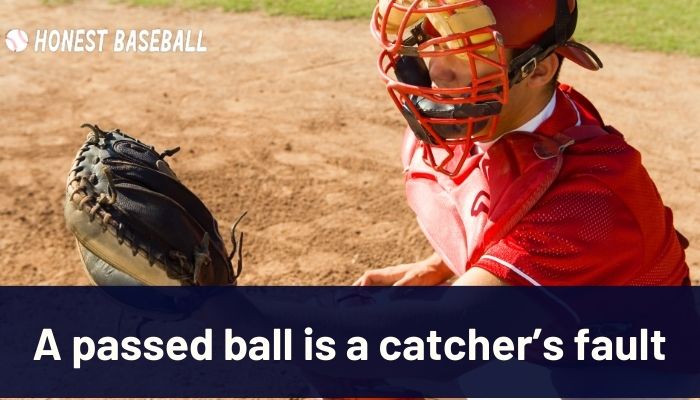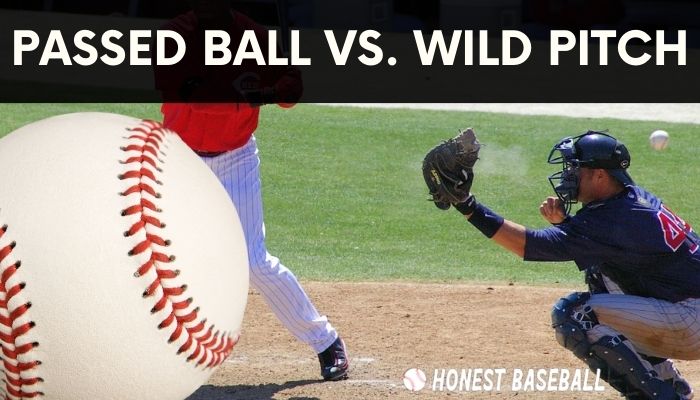A passed ball is when the catcher misses a pitch they should have caught. The official scorer will say it was a passed ball if the catcher should have been able to catch it with an ordinary effort.
On the other hand, a wild pitch is when the catcher can’t catch it because the pitch is too high, low, or wide.
The passed ball is considered the catcher’s fault, and the wild pitch is the pitcher’s fault. In both cases, at least one runner must advance to the next base.
By the way, these are just glimpses of the ocean of passed ball vs wild pitch. In this guide, I will explain everything about both pitches, which will help you understand them.
What Is a Passed Ball?

The official baseball scorer charges a catcher with a passed ball when the catcher fails to hold or control a legal pitch.
But why this is given as a passed ball to the catcher by the official scorer for the following considerations:
- In the scorer’s judgment, the catcher should have controlled the ball with ease and shouldn’t have missed it to hold onto his mitt.
- He could catch the ball with ordinary effort.
- The batter or any other baserunner (s) advance to the next base.
- The batter could be struck out or not (I will explain this later in detail).
A passed ball is considered a fault of the catcher but not an error. This is not an error because the passed ball isn’t a part of the fielding.
What Is a Wild Pitch?

The official scorer charges the pitcher with a wild pitch when the catcher fails to control and hold a legal ball due to the pitcher’s fault. A wild pitch is considered a wild pitch when the following scenarios take place:
- The pitch pitches a legal pitch but too errantly. For example, the ball is too high, too low, or too wide.
- The catcher can’t control the ball with an ordinary effort.
- The ball allows the batter or the runner(s) to advance to the next base(s).
- The ball is grounded or touches the home plate before reaching the catcher.
A wild pitch is a pitcher’s fault but not an error. Like the passed ball, this is not an error because it is also not a part of the orthodox fielding.
Passed Ball Vs Wild Pitch: What Is the Actual Difference?
Since both the passed ball and the wild pitch allow the batter and runner(s) to advance the next base(s), what is the difference between them?
Okay, there are some significant differences when talking about passed ball vs wild pitch. The differences are discussed in the following table.
| Passed Ball | Wild Pitch |
| The passed ball is the fault of the catcher; the catcher is solely charged for the passed ball. | A wild pitch is the fault of the pitcher, and the pitcher is solely charged for the wild pitch. |
| When it is a passed ball, and the batter or the runner scores a run, it is NOT CONSIDERED an earned run. | When it is a wild pitch, and the batter or the runner scores a run, it is CONSIDERED an earned run, and it goes against the pitcher’s ERA. |
These are the differences between a passed ball and a wild pitch. But, except for these, all other rules for both balls are the same. So, let’s check out all other rules regarding passed balls and wild pitches.
Similarities: All Other Rules About a Passed Ball and a Wild Pitch
As I mentioned before, aside from two differences, all other rules are the same for both passed balls and wild pitches. Here, I will discuss all the other rules.
Note: Please check these with proper attention. Some may seem complicated to some people. But, after understanding these, you will clearly understand all the rules about the passed balls and wild pitches.
The following rules I described are according to the official baseball rules of 2023 of 9.07(a), 9.12(e), (f), and 9.13.
Rule 1: StrikeOut and a Passed Ball/Wild Pitch
Let’s say the batter already has two strikes. Alongside, the passed ball/wild pitch becomes a strike, and the batter manages to advance to first base.
In this case, the official scorer will declare this a passed ball/wild pitch, and it will also be a strikeout.
Rule 2: Passed Ball/Wild Pitch and Out
In the situation of a ball that could be a passed ball/wild pitch, but the catcher outs the runner on any base, the scorer will not charge it as a passed ball or wild pitch.
Here’s an example:
- The catcher missed the ball due to his fault or due to an errant pitch,
- The runner on the first base starts to advance to the second base,
- The catcher recovers the ball and throws it to the second base,
- The second baseman retires the runner before he reaches second base.
So, in this situation, the runner gets out, and the scorer won’t charge the catcher or the pitcher a passed ball or wild pitch.
| See Also: 2 Seam Vs 4 Seam Fastball |
Rule 3: Passed Ball/Wild Pitch, Outs, and Fielder’s Choice
Consider the following scenario:
- It is the third strike,
- The ball is initially a passed ball/wild pitch,
- The batter advances to the first base,
- Any other runner starts to advance to the next base and gets out,
- Another baserunner successfully advances to the next base.
In this case, the official scorer will score the following:
- The batter is strikeout.
- The runner who gets out before reaching the next base is putout.
- If any fielder receives the ball before retiring the runner and throws it to the base to retire the runner, it will be scored as an assist.
- The second runner who successfully advanced to the next base scored a fielder’s choice.
Here, the runners can be on any base.
Rule 4: Wild Pitch/Passed Ball and Stolen Base
Consider the following scenario of a baserunner:
- The runner advances to the next base after the ball is pitched by the pitcher, and the ball becomes a passed ball.
In this case, the runner won’t be credited with a stolen base. As I mentioned before, this will not be an error as well. This will be a simple run by the baserunner.
Aside from this, consider another scenario:
- The pitcher starts to pitch,
- The runner starts to approach the next base before the pitch is delivered, and it becomes a wild pitch or a passed ball,
- The runner successfully advanced to the next base.
In this case, the runner will be credited with a stolen base.
But,
- If the catcher throws the ball to any base, and the runner advances to an additional base because the throw is missed by the fielder.
In this case, the official scorer will score it as a wild pitch/passed ball, a stolen base, and an error.
Final Words
I hope the discussion above about passed ball vs wild pitch clears the core differences between a passed ball and a wild pitch.
Aside from the differences, all other rules are similar for both passed balls and wild pitches. I discussed every existing rule for them according to the latest official baseball rules.
After reading the guide, all rules regarding the passed balls and wild pitches should now be clarified to you. However, if you are still confused, I would recommend you recheck the rules again.
You May Also Like the following:
Softball Swing VS Baseball Swing
Travel Baseball Vs Little League
Meta Description:

Hello everyone. My name is Jason Butler, and I live in California, America. I was a professional AAA Minor League Baseball player. I lost my chance of playing MLB for injury issues, but I did not lose my love for baseball. I attended the coaching training program and am now working as a coach in a small school in San Diego.
I always love to share my experience and knowledge if that can help you. Play baseball, and stay fit.
